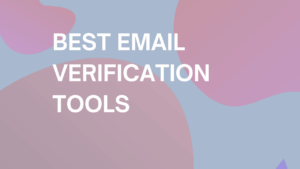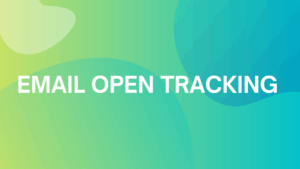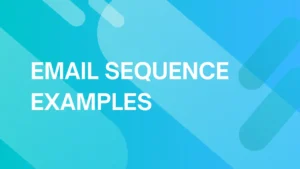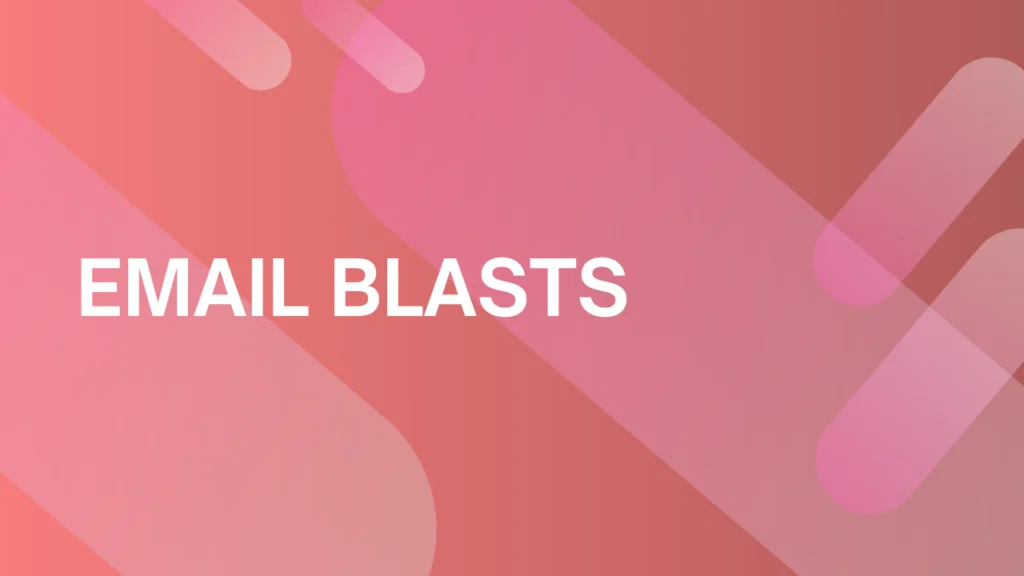
Email Blasts: What Are They & How to Send Them?
⚡ TL;DR (Quick Answer)
- The Definition: An email blast is a single message sent to a large audience simultaneously (like a newsletter or flash sale).
- The Strategy: Only use blasts for broad appeals (launches, events). Use targeted campaigns for nurturing specific leads.
- The Rules: Never use standard Gmail/Outlook for blasts. Use an ESP (like Mailchimp or Brevo) to handle the volume.
- The Success Factor: Clean your email list first to remove invalid addresses and segment your audience to increase relevance.
If you’ve ever wondered whether email blasts are just modern-day spam, you’re not alone. The term “blast” doesn’t exactly scream relevance or precision. In an age of smart inboxes and personalization, the idea of sending one generic message to hundreds or thousands of people at once might seem like a bad idea.
But here’s the thing — when used strategically, email blasts can still be a powerful part of your marketing toolkit.
In this guide, we’ll break down what email blasts really are (and aren’t), when to use them, and how to do them the right way — without tanking your deliverability or annoying your audience.
You’ll learn:
- When email blasts work (and when they don’t)
- A step-by-step method for sending effective blasts
- Common mistakes to avoid
- Templates and examples you can use today
Let’s dive in.
What is an email blast?
An email blast (sometimes referred to as an e-blast) is a common email prospecting technique that involves the distribution of a single email message to a large recipient list all at once.
Tip: Take a deep dive into “What is sales prospecting?“
Unlike targeted marketing campaigns, email blasts don’t typically employ strategic targeting or segmentation, which is why they’re sometimes perceived as unsolicited or spammy types of communication.
Despite their broad nature, these blasts can be a great tool to reach a large audience, aiming for visibility and reach rather than personal connection.
However, for more personalized communication, you might want to learn how to send an email to multiple recipients individually.
When to use an email blast (and when a targeted campaign is better)
Email blasts can get a bad rap, and for good reason. When done poorly, they’re impersonal, untimely, and irrelevant. But used wisely, they’re one of the fastest ways to get your message out to a large audience.
So when should you hit “send” on a blast? And when is a more tailored campaign the better choice?
Use an email blast when…
- You’re announcing a flash sale or limited-time offer. Email blasts shine when urgency is key. Got a 24-hour deal or exclusive discount? A one-time blast can quickly generate buzz and traffic, especially if your subject line and CTA are on point.
- You’re launching a new product. For businesses that specialize in a narrow set of offerings, like children’s clothing or niche software tools, a well-crafted blast can instantly inform your audience about a new arrival or update.
- You’re promoting an event or giveaway. Webinars, contests, and product launches benefit from wide exposure. An email blast ensures everyone hears about it at the same time — maximizing participation.
- You’re sending a newsletter. If your newsletter is relevant to your full subscriber list, a blast is the most efficient way to deliver it. Just make sure it’s scannable, useful, and visually engaging.
Skip the blast and go targeted when…
- You’re welcoming a new subscriber. A generic blast won’t feel personal to someone who just joined your list. Use a targeted welcome email with personalized onboarding content instead.
- You’re recovering abandoned carts. These are moments that call for personalization. A targeted email referencing the exact product left behind will always outperform a mass message.
- You’re nurturing leads. Relationship-building requires context. Drip campaigns or segmented series work far better than one-size-fits-all blasts in these scenarios.
- Your offer isn’t relevant to everyone. Got a location-specific deal or a product that only applies to a certain segment? Filter your list. A poorly targeted blast increases unsubscribes and risks being marked as spam.
Is an email blast the same as an email bomb?
An email blast, in the context of marketing, refers to sending a single email to a large group of recipients at once. Email blast marketing is a legitimate marketing tactic used to broadcast information to a wide audience quickly.
Typically, these blasts are part of a broader marketing strategy and are used to inform, promote, or announce specific products, services, or events to a large audience.
On the other hand, an email bomb is an act of internet abuse and is considered a malicious attack.
It involves sending a large volume of emails to an individual or server, with the intention of overwhelming the system or harassing the recipient.
This can lead to overloaded email servers and can disrupt an individual’s ability to receive and manage their emails effectively.
Unlike email blasts, email bombs are not a part of any legitimate marketing practice and are often associated with spam or cyber attack tactics.
| Tip: If you would like to learn more about spammy practices in email marketing, make sure to check this article: 12 reasons your emails are being sent to spam. |
Email blasts vs. email campaigns
Understanding the difference between an email blast and an email campaign is key to using each effectively.
An email campaign is a sequence of emails sent to a specifically targeted group of recipients.
These campaigns are strategic and designed to build a relationship with the recipient over time.
They are often used to increase brand awareness, maintain regular contact, and ultimately drive sales.
Email campaigns are characterized by their targeted nature and the strategic planning that goes into crafting each message in the series.
In contrast, the primary goal of an email blast is to disseminate a message to as many people as possible through a single email.
This approach is less about fostering ongoing relationships and more about making an immediate impact.
While both email blasts and campaigns are integral to a comprehensive email marketing strategy, they serve distinct purposes and should be used according to their strengths and the specific goals of the marketing plan.
How to send an email blast (the right way)
Sending an email blast isn’t just about crafting a message and hitting “send.” To get real results and avoid landing in spam folders, you need a strategic approach. Follow these five steps to make your blasts effective, compliant, and engaging.
Step 1: Use an Email Service Provider (ESP)
Before you do anything else, set yourself up with a reliable Email Service Provider (ESP) like Mailchimp, ConvertKit, or Brevo.
Why this matters:
- Deliverability: ESPs are built to get your emails past spam filters and into inboxes.
- Compliance: They help you follow email marketing laws like CAN-SPAM and GDPR.
- Analytics: You’ll get insights on opens, clicks, and unsubscribes — essential for improvement.
- Design tools: Most ESPs offer drag-and-drop editors, responsive templates, and automation options.
Avoid sending bulk emails from Gmail or Outlook. You’ll hit sending limits quickly, and worse, your emails are likely to be flagged as spam.
Step 2: Build and clean your list
Next, make sure you’re emailing the right people.
- Get consent: Use opt-in forms where subscribers clearly agree to receive emails from you.
- Clean your list regularly with tools like EmailListVerify. This removes invalid or outdated addresses and prevents bouncebacks.
- Watch for warning signs: A 550 permanent failure error means the email address no longer exists — delete it from your list to protect your sender reputation.
A clean list keeps your deliverability high and your email performance strong.
Step 3: Segment your audience
Even if you’re sending a one-time blast, segmentation can dramatically boost your results.
- What is segmentation? It means breaking your list into smaller groups based on behavior, interests, or demographics.
- Why it matters: Sending a discount to recent buyers feels relevant. Sending the same discount to someone who hasn’t opened your emails in months? Not so much.
- Easy examples:
- New subscribers vs. loyal customers
- Active users vs. dormant ones
- Location-based segments (such as promotions in specific cities)
The more relevant your message, the more likely it is to be opened and acted upon.
Step 4: Craft your message
Now it’s time to create your email. Keep it clear, compelling, and focused.
Here are the four essentials to get right:
- Subject Line: This is the first thing people see, so make it count. Keep it short, specific, and curiosity-piquing.
- Body Copy: Write concise, scannable text. Use short paragraphs, bullet points, and bold headlines to guide the reader.
- Visuals: A clean layout with high-quality visuals (like product images or gifs) grabs attention and reinforces your message.
- Call-to-Action (CTA): Don’t be shy. Tell readers exactly what you want them to do — “Shop Now,” “Claim Your Discount,” “Join the Webinar,” etc.
Even a mass email can feel personalized when it’s thoughtfully written and designed.
Tip: For those days where words fail you, try our free AI email writer to generate emails based on tone, recipient, and message in seconds.
Step 5: Test and analyze
Before hitting send to your full list:
- Send yourself a test email: Check how it looks on desktop and mobile. Proofread for typos and broken links.
- Preview across devices and inboxes: Make sure it renders properly in Gmail, Outlook, and Apple Mail.
After sending your blast:
- Track your results: Key metrics include open rate, click-through rate (CTR), bounce rate, and unsubscribes.
- Use insights to improve: Did certain segments respond better? Was your subject line strong enough? Take notes for your next campaign.
Tip: Besides personalization, you should always properly warm up your inboxes before you start sending email blasts to your email contacts. In order to do that, you can try Warmup Inbox and prepare your email addresses for any future email blasts or overall email campaigns.
[Try 7 days free]
If you’d like to learn more about the email-warmup process, make sure to check out our comprehensive Email Warm Up Guide.
Things to avoid when sending email blasts
Navigating the complex world of email marketing requires not only knowing what works but also understanding what doesn’t.
Certain practices in email blasting, though seemingly efficient, can actually backfire and damage a brand’s reputation and effectiveness in reaching its audience.
1. Don’t include irrelevant email content
Firstly, mass mailing, a common but misguided approach, often leads to sending undifferentiated content to a vast audience without considering their unique preferences or behaviors.
This lack of personalization not only diminishes the potential impact of the message, but also increases the risk of recipients disregarding the emails as irrelevant or, worse, marking them as spam.
The key issue here is the failure to acknowledge the diverse needs and interests of the audience, leading to a one-size-fits-all email that resonates with few, if any.
2. Avoid list linking
List linking, another questionable tactic, involves the sharing or merging of email lists without the explicit consent of the individuals on those lists.
This practice raises both ethical concerns as well as legal ones, particularly under regulations like GDPR.
It often leads to sending emails to recipients who have no prior relationship or interest in the brand, resulting in low engagement rates and potential damage to the sender’s reputation.
3. Don’t send large email attachments
Lastly, zip bombing, an even more problematic technique, involves sending emails with excessively large attachments.
This method can lead to significant issues like overwhelming recipients’ email storage, causing annoyance, and potentially being flagged as malicious activity.
It’s a practice that’s not just ineffective, but also counterproductive, as it strains the relationship between the sender and the recipient.
Email blast templates & examples
To craft an effective email blast, a good design and using the right message for the right moment is critical. Below are three common use cases, complete with examples and quick breakdowns of what makes each one work.
Example 1: The flash sale
Use this when: You want to generate buzz and drive immediate conversions for a limited-time offer.

Why it works:
- Bold headline with urgency: “60% OFF” grabs immediate attention and sets the tone.
- Promo code is highlighted: “REDDHOT” is visually framed, making it easy to find and remember.
- Clear timeframe: Dates are called out (“Sessions… Thursday 8/1 – Friday 8/9”), adding urgency.
- Visual appeal: The vibrant design and themed artwork create excitement.
- Prominent CTA: “Book Now” and “Find Events” buttons stand out with contrasting colors.
Bonus tip: Flash sales benefit from vibrant design, bold discounts, and tight deadlines — this email nails all three.
Example 2: The event invitation
Use this when: You’re promoting a webinar, video series, or live event and want attendees to register or tune in.

Why it works:
- Clear branding: “BRANDWAGON” stands out as a visually distinct banner.
- Engaging hero visual: Featuring a recognizable brand mascot and speaker image helps draw viewers in.
- Concise copy: A quick intro tells you what to expect and why it matters.
- Strong CTA: “Watch the episode” is action-oriented and low-friction.
Bonus tip: If promoting a recorded or live event, always lead with the value proposition — what the user will learn or gain by attending.
Example 3: The new product announcement
Use this when: You’re launching a product and want to introduce it to your audience with a bang.
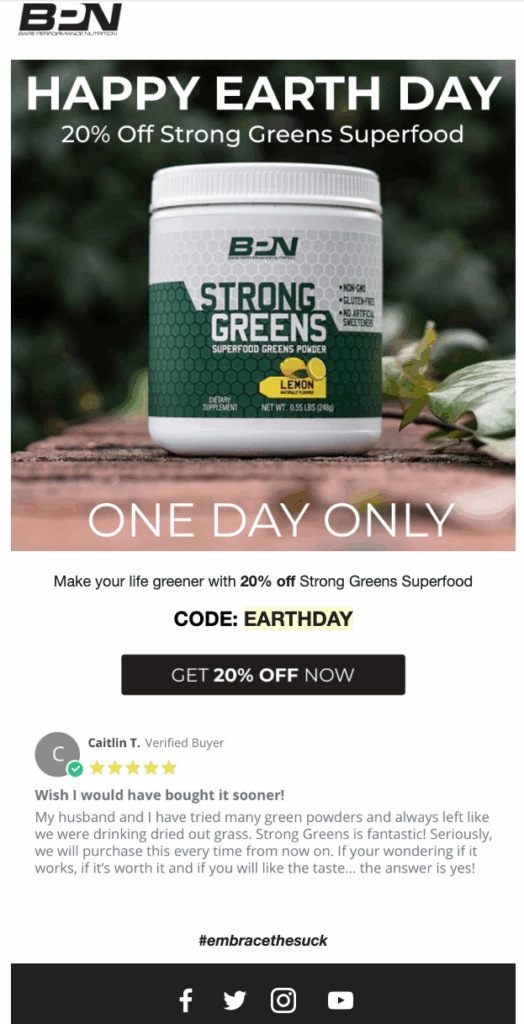
Why it works:
- Timely hook: Tied to Earth Day, which makes it feel current and relevant.
- Hero product placement: The Strong Greens jar is front-and-center, instantly recognizable.
- Discount + urgency: “20% Off — One Day Only” compels immediate action.
- Social proof: The user testimonial adds trust and authenticity.
- CTA clarity: “Get 20% OFF NOW” is specific, benefit-driven, and visually prominent.
Bonus tip: Pairing a launch with a themed moment (like a holiday) and a time-sensitive offer makes your announcement harder to ignore.
Frequently asked questions
Still have questions about email blasts? Here are quick answers to some of the most common ones marketers ask:
What is a good open rate for an email blast?
A good open rate can vary by industry, but generally:
- 17–28% is average or good
- 20% or higher is considered strong
- Rates under 10% may signal issues with your subject line, list quality, or sender reputation
Want to improve open rates? Focus on crafting compelling subject lines and regularly cleaning your email list.
How often should I send email blasts?
It depends on your audience and your content. Here are some rough guidelines:
- 1–2x per week is a safe range for most businesses
- Avoid sending blasts daily unless it’s part of a high-value campaign (like a product launch countdown)
- Test and monitor unsubscribe rates — that’s your best signal for frequency
Can I send an email blast from my Gmail or Outlook account?
Technically, yes. Strategically, no. Sending mass emails from personal inboxes like Gmail or Outlook:
- Risks hitting spam filters
- Has limited sending capacity (Gmail caps around 500/day)
- Doesn’t offer essential tools like list management, analytics, or compliance features
Always use a professional Email Service Provider (ESP) for proper deliverability and control.

